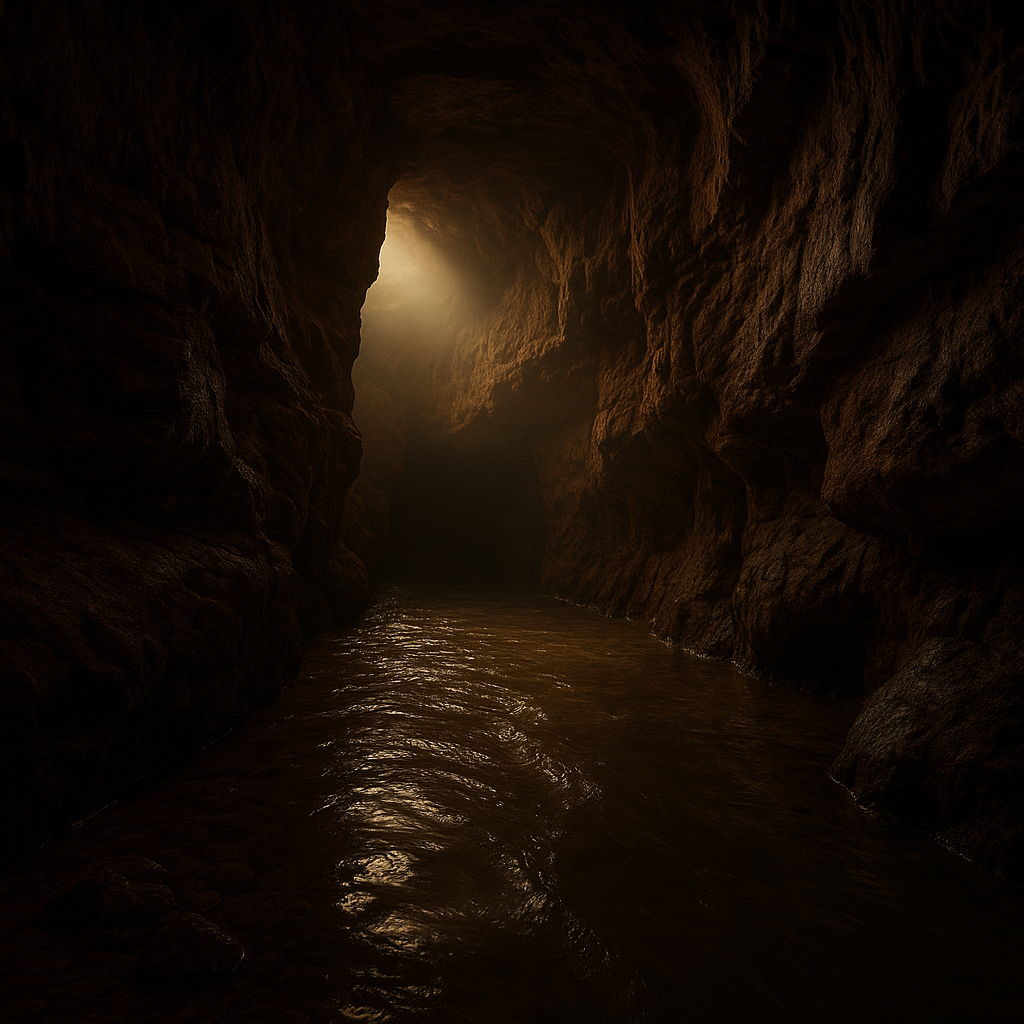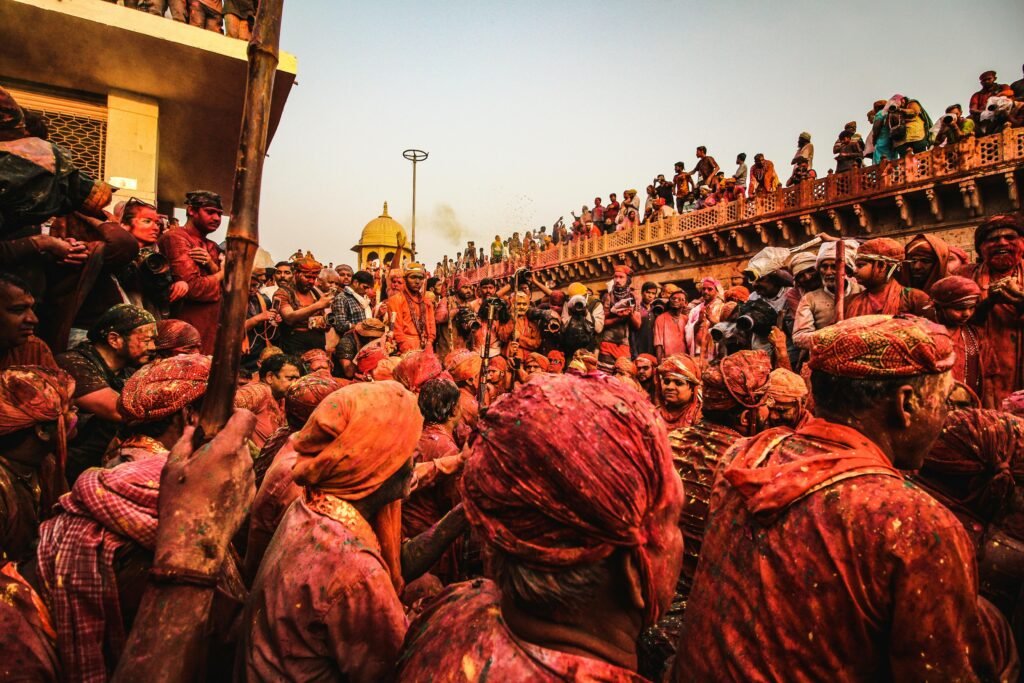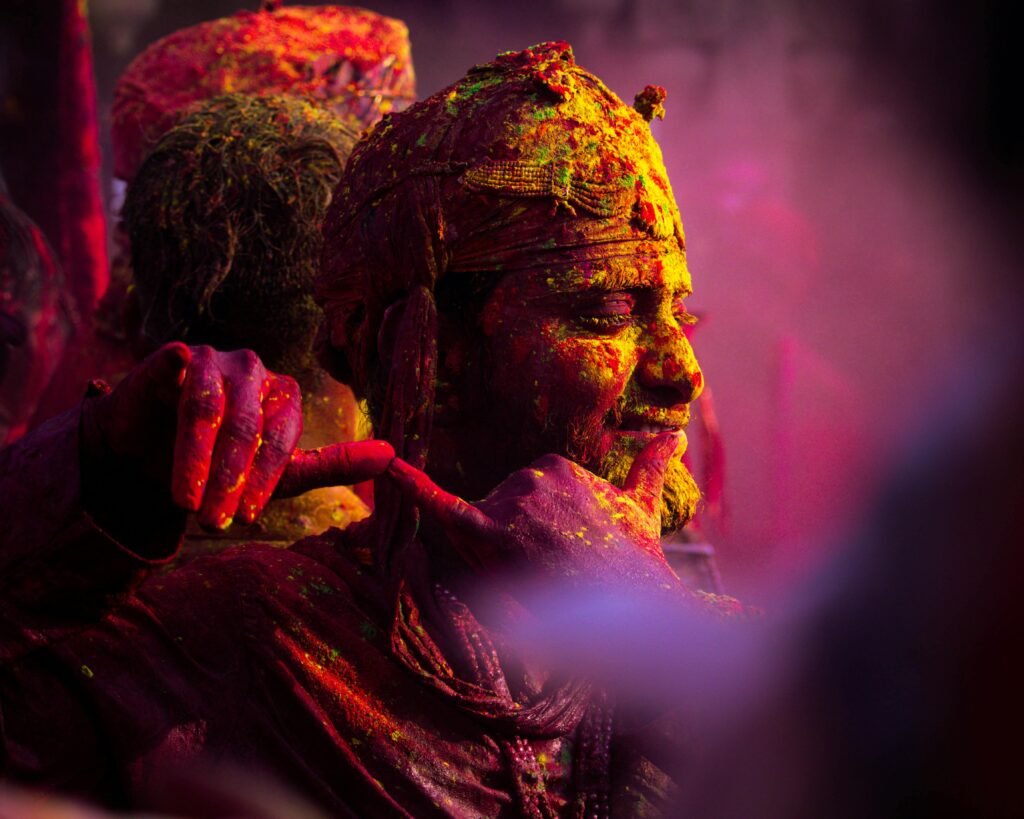
Beneath Bidar’s Manichoola Hills Flows a Divine Mystery…
Welcome to Jharani Narasimha Swamy Temple, a place where spirituality flows—literally. Hidden under the Manichoola hills in Bidar, Karnataka, this temple is unlike anything you’ve seen before.
Here, you don’t just walk into a temple. You wade through 300 meters of waist-deep, sacred water flowing through a dark, narrow cave. The experience is thrilling, mysterious, and deeply spiritual—all at once.
The water is believed to be a holy stream formed by a demon named Jharasura, who was once blessed by Lord Shiva. When he was later slain by Lord Narasimha, the demon requested moksha. Upon granting it, Lord Narasimha turned him into a stream—forever serving the Lord’s feet. That stream is what flows through the cave today!
You walk barefoot, chanting “Narasimha Hari-Hari” as the water cools your legs and calms your mind. It’s dark inside, and bats sometimes flutter above—but fear fades fast when faith takes over.
At the end of the cave, you get darshan of a swayambhu (self-manifested) Lord Narasimha idol. Just beside Him is a Shiva Linga, also bathed in this sacred water.
Where else can you see Lord Vishnu and Lord Shiva worshipped together inside a natural cave?
This is more than a temple visit—it’s a journey into your own devotion.
Make sure to add Jharani Narasimha Swamy Temple to your next spiritual travel list!
Temple at a Glance – Quick Facts Before You Step In!
The Jharani Narasimha Swamy Temple is tucked away in a peaceful area called Mangalpet, near Pakalwada, just 4.8 km from Bidar. You can easily get here by auto or cab. The journey itself feels like a little yatra—simple, short, but filled with spiritual energy.
Now, here comes the exciting part. To reach the main sanctum, you’ll walk through a 300-meter-long cave tunnel. Sounds like an adventure, right? But this isn’t just any cave walk—you walk waist-deep in holy water that stays cool all year round. The depth goes up to 4–5 feet, so keep your balance and keep chanting!
This isn’t a man-made stream. It is said to be the divine form of Jalasura, a demon who once worshipped Lord Shiva inside this very cave. When Lord Narasimha defeated him, the demon begged for moksha. The Lord, in His mercy, granted it and turned him into a sacred stream that now flows through the cave. So yes—you are literally walking on devotion!
Inside the cave, you will get darshan of Swayambhu Narasimha—that means the Lord appeared here by Himself, not made by human hands. Beside Him, you’ll also find a Shiva Linga, constantly bathed by the flowing stream. This union of Vishnu and Shiva makes this temple truly rare and special.
It’s also recognized as one of the 108 Abhimana Kshethras—highly respected Vishnu temples that hold immense spiritual importance in the Vaishnava tradition.
So, if you’re planning a visit to the Jharani Narasimha Swamy Temple, remember—it’s not just a walk in water. It’s a walk into history, legend, and divine grace. A journey your soul will thank you for.
The Legend: From Demon to Devotee

Every great temple has a story. The Jharani Narasimha Swamy Temple has one that flows—literally.
Long ago, a demon named Jharasura (also called Jalasura) lived in the caves beneath the hills of Bidar. But unlike other asuras, Jharasura had a unique side—he was a devotee of Lord Shiva. He spent years meditating and worshipping inside the cave.
According to the local legend, Lord Narasimha—the fierce fourth avatar of Lord Vishnu—arrived here after slaying Hiranyakashipu. Jharasura, believing Narasimha to be a threat, challenged Him to a battle.
The battle was intense. But how could a demon stand against the Lord Himself?
In the end, Jharasura was defeated. But instead of seeking revenge or cursing his fate, he made a humble request. He asked Lord Narasimha for moksha—freedom from the cycle of birth and death.
The Lord, pleased by the demon’s surrender and devotion to Shiva, granted him moksha. He then turned Jharasura into an eternal stream flowing inside the cave—forever at His feet.
Today, you walk through this same stream to reach the sanctum. You may not see Jharasura, but you walk over his surrendered soul.
This story from the Jharani Narasimha Swamy Temple teaches you a deep truth—devotion can transform anyone. Even a demon can become divine with grace.
The stream you walk through isn’t just water—it’s a symbol of surrender, humility, and divine acceptance.
So next time you visit, don’t rush. Let the sacred stream cleanse your feet, and maybe even your heart. 🌸
A Pilgrim’s Journey: The Water-Filled Cave
Your spiritual journey at the Jharani Narasimha Swamy Temple begins with water—not bells or flowers.
You’ll enter a narrow cave where a stream flows waist-deep for 300 meters. In some parts, the water reaches your chest. The floor is made of slippery laterite rock, so walk slowly. Some say even the floor tests your surrender.
Inside, it’s dark and cool. You’ll see bats flying overhead, but don’t worry—they’re used to pilgrims. The natural cave has low ceilings and turns. Keep your head low, and your heart high in devotion.
You might chant “Govinda Govinda” or “Narasimha Hari-Hari” as you walk. These chants echo through the tunnel and fill it with vibrations. The sulphur-rich spring water is believed to heal skin problems. Locals even call it “jalamrit”—the nectar stream.
The temple provides basic infrastructure—there are lights, ventilation shafts, and changing rooms near the entrance and exit. You can rent torches if needed. Still, it’s best to carry your own.
Once you reach the sanctum, prepare to wait. The cave room fits only eight devotees at a time. Others stand in water, waiting patiently for their moment. It’s a test of shraddha (faith) and saburi (patience).
At the end of the cave, you see Swayambhu Narasimha Swamy and the Shiva Linga, glowing dimly under diyas. It’s a moment you’ll never forget.
Many say they feel lighter—body, mind, and soul—as they step back into the sunlight. The Jharani Narasimha Swamy Temple isn’t just a darshan—it’s an inner cleansing. A divine dip into surrender.
Jalasura flows under your feet. Narasimha watches from ahead. And your faith walks with you.
Healing & Devotee Beliefs at Jharani Narasimha Swamy Temple

The Jharani Narasimha Swamy Temple is more than a place of worship—it’s also believed to be a place of healing.
As you walk through the cool cave water, you’re not just wading in a stream. You’re walking through the sacred Jalasura dhara—the divine stream that once was a demon.
This water isn’t ordinary. It’s naturally sulphur-rich, and locals say it has medicinal properties. Many believe it helps cure skin infections, allergies, and boils. Pilgrims often visit here when home remedies fail.
In Ayurveda, sulphur water is said to balance skin-related doshas. No wonder devotees call it “jal prasad.”
The spring inside the cave has never dried, not even in the hottest summers. That’s why the cave is called Jharani—meaning “eternal flow.”
Couples visit the temple with a special prayer. They walk through the water with the hope of conceiving a child. The Lord is said to bless sincere devotees with fertility.
Some women tie red bangles at the cave entrance after their wish is fulfilled. It’s a quiet ritual of gratitude.
At the Jharani Narasimha Swamy Temple, the water flows with grace, healing, and hidden blessings.
So if your body or heart needs healing, maybe it’s time you let the waters guide you.
Visitor Info & Practical Guide for Jharani Narasimha Swamy Temple
Planning a trip to the Jharani Narasimha Swamy Temple? Here’s everything you need to know before you step into the sacred stream!
🕰️ Temple Timings: The temple usually opens at 7:00 AM and closes by 6:00 PM. Some sources say there’s a break between 1:00 PM and 3:00 PM for cleaning or priest rituals, so early mornings or late afternoons are ideal for peaceful darshan.
🌤️ Best Time to Visit: Visit between October and March. The weather stays cooler, and the water level is safe and stable. During the summer months, walking through the dark water cave can feel tiring due to heat and humidity.
🎒 What to Carry: Bring water-friendly clothes—avoid jeans or anything heavy. Carry a flashlight or use your phone torch as the cave is dimly lit. The laterite rock floor can be slippery, so walk slowly. The temple has changing rooms on-site for both men and women.
🛣️ How to Reach: The temple is just 5 km from Bidar railway station. If you’re flying in, the nearest airport is Rajiv Gandhi International Airport, Hyderabad, which is around 120 km away. You can take a cab or bus from there.
🚻 Facilities: The temple trust has arranged toilets, changing areas, parking, and a multipurpose hall for small spiritual events. Roads leading to the temple have been improved recently, making it easier for pilgrims.
Visiting the Jharani Narasimha Swamy Temple is not just a darshan—it’s a divine trek. Lord Narasimha tests your body but heals your soul. Take each step with faith and you’ll feel the grace flow right under your feet.
Why Jharani Narasimha Swamy Temple Is Truly Unique
The Jharani Narasimha Swamy Temple isn’t just another holy place—it’s a spiritual experience unlike any other in India.
It is the only cave temple in India where you walk through waist-deep water for 300 meters to reach the sanctum. This journey feels more like a test of devotion than a simple darshan. The cool water, dark tunnels, and echoing chants remind you—you’re on sacred ground.
You don’t just visit this temple. You surrender to it.
What makes it more divine? Two powerful deities live together here—Lord Narasimha and Lord Shiva. It’s rare to find both Vaishnav and Shaiv energies in the same sanctum. This unique harmony reflects our Hindu tradition—all paths lead to one truth.
Inside the cave, you’ll find a swayambhu idol of Lord Narasimha. That means the Lord manifested on His own, without any sculptor’s touch. These idols are said to hold immense spiritual energy. Pilgrims believe even a moment’s darshan here burns lifetimes of bad karma.
Just beside Him flows a stream—believed to be the transformed soul of demon-turned-devotee Jalasura. This legend teaches us: Bhakti can turn demons into water that washes the Lord’s feet.
If you’re looking for a temple that’s raw, powerful, and deeply personal, the Jharani Narasimha Swamy Temple is your calling.
It’s not just a place. It’s an experience that walks with you—step by sacred step.
Pilgrim Testimonials / Social Proof
Visiting the Jharani Narasimha Swamy Temple is unlike any other spiritual experience. Many pilgrims call it a “thrilling journey of faith.” You walk through 300 meters of waist-deep water inside a natural cave. It feels like a test of your devotion and courage.
Travelers often say the temple’s spiritual aura is enchanting. The dim cave, dripping water, and soft chants create a peaceful atmosphere. One devotee shared how the cool water washed away not only dirt but also stress and worries.
You’ll find many stories of people who felt healed after their visit. The water flowing inside the cave is said to have medicinal properties. Pilgrims seeking blessings for health or children often return with joyful news. This temple is a symbol of devotion turning obstacles into blessings—just like how Lord Narasimha’s fierce avatar protects and uplifts devotees.
The Jharani Narasimha Swamy Temple has inspired numerous YouTube videos and reels. These video pilgrimages show the real-time experience of walking through the cave water, making it easier for first-timers to prepare mentally. You can find these videos on platforms like YouTube and Instagram, which capture the temple’s mystical vibe.
These testimonials and videos are proof that the temple is more than just a place. It’s a spiritual journey that tests your faith and rewards your heart. So, when you visit, remember you’re joining a long tradition of devotees whose lives were touched by this divine cave.
Nearby Places to Visit
If you visit the Jharani Narasimha Swamy Temple, don’t miss the chance to explore nearby attractions. Bidar has many beautiful sites to make your trip special.
Start with the famous Bidar Fort, only 5 km from the temple. This grand fort was built in the 15th century by the Bahmani rulers. Walking through its ancient walls, you can almost hear the echoes of royal life. The fort’s architecture mixes Persian and Indian styles, giving you a glimpse into Bidar’s rich history.
Nearby, the Gurudwara Nanak Jhira Sahib is a peaceful place where you can feel calm and spiritual. It honors Guru Nanak, the founder of Sikhism, who visited Bidar in the 16th century. The fresh water spring here is said to have appeared by divine grace.
For another divine stop, visit the Papanash Shiva Temple. Legend says bathing in the temple’s pond washes away all your sins. The temple’s spiritual energy will deepen your faith after your experience at the Jharani Narasimha Swamy Temple.
Don’t forget the Bahmani Tombs, majestic mausoleums of the Bahmani rulers, just 2 km away. Their Indo-Islamic architecture is breathtaking and tells stories of power and devotion.
Together, these sites make a wonderful spiritual and cultural circuit around Bidar. You can experience history, faith, and mystery—all in one trip!
Conclusion
Walking through water to witness a living legend—that’s the experience at Jharani Narasimha Swamy Temple in Bidar. This temple is unlike any other. You wade 300 meters through cool, sacred water inside a dark cave. It’s an adventure and a spiritual journey all in one.
The temple is home to a swayambhu Narasimha idol, meaning the Lord appeared here naturally, not crafted by human hands. Nearby, a Shiva Linga flows with holy water from the eternal stream of Jharasura—a demon turned into a sacred river by Lord Narasimha’s grace. This unique blend of Vaishnav and Shaiv devotion is rare and powerful.
As you walk, feel the cool water cleanse your feet and mind. The journey teaches surrender, patience, and faith—qualities praised in many Hindu stories. Just like the demon Jharasura found peace through devotion, you too can find calm walking this sacred path.
If you want to explore this divine trek safely and meaningfully, the DivyaKripa app is your perfect guide. It offers travel guides, interactive maps, legends, and audio stories to enrich your pilgrimage.
Download the DivyaKripa app today and start your journey to the mystical Jharani Narasimha Swamy Temple—where faith flows with every step.


